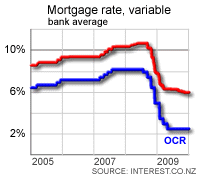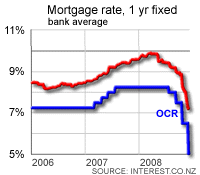 Given the Reserve Bank has suggested banks are building up their profit margins by not passing on wholesale rate cuts to customers, it's worth looking at what has happened to bank interest rates since the Reserve Bank started cutting the Official Cash Rate on July 24. Data collected by interest.co.nz shows the average bank variable mortgage rate has fallen 253 basis points to 8.11% today from 10.64% in the week before the OCR was cut on July 24. Over that period the OCR was cut 325 basis points to 5%. The average 6 month mortgage rate has fallen by 249 basis points to 7.25% today, while the average 1 year rate has fallen 225 basis points to 7.18% and the average 2 year rate has fallen 181 basis points to 7.38.
Given the Reserve Bank has suggested banks are building up their profit margins by not passing on wholesale rate cuts to customers, it's worth looking at what has happened to bank interest rates since the Reserve Bank started cutting the Official Cash Rate on July 24. Data collected by interest.co.nz shows the average bank variable mortgage rate has fallen 253 basis points to 8.11% today from 10.64% in the week before the OCR was cut on July 24. Over that period the OCR was cut 325 basis points to 5%. The average 6 month mortgage rate has fallen by 249 basis points to 7.25% today, while the average 1 year rate has fallen 225 basis points to 7.18% and the average 2 year rate has fallen 181 basis points to 7.38.
This suggests that banks have been building up or at least protecting their margins over this period, although the extent of any margin expansion will not be clear until data is received from all the bank General Disclosure Statements for the quarter to September 30 and the data is collated by the Reserve Bank. RBNZ data in its last Financial Stability Report actually show net interest income as a percentage of average interest-earning assets fell to 2.12% as at June 30 from 2.16% a year earlier.  This will not reflect the latest moves on interest rates, in particular moves in business interest rates and credit card rates. Gross margins on these will have expanded significantly since June because the banks have kept the effective interest rate on interest bearing credit card balances steady at 19.8% since the OCR cuts began on July 24 and business rates have either not fallen or in some cases increased, depending on a busineses risk profile. Consistent data on business interest rates is harder to find because rates vary so much from business to business and even within businesses, but anecdotal feedback is that effective interest rates have remained high despite the OCR cuts since July. The net interest margin and the bottom line effects are much tougher to extrapolate because of the differences in balance sheet structures, fees and costs. Bollard said yesterday the Reserve Bank had observed some increases in margins in recent months and it was now time to 'share the pain' by allowing those margins to fall back. * This article was first published on Friday in our daily subscription newsletter for the banking and finance industries. The email costs NZ$365 per annum and carries exclusive news and analysis for New Zealand banking and finance industry executives, regulators and investors. Sign up for a free trial here.
This will not reflect the latest moves on interest rates, in particular moves in business interest rates and credit card rates. Gross margins on these will have expanded significantly since June because the banks have kept the effective interest rate on interest bearing credit card balances steady at 19.8% since the OCR cuts began on July 24 and business rates have either not fallen or in some cases increased, depending on a busineses risk profile. Consistent data on business interest rates is harder to find because rates vary so much from business to business and even within businesses, but anecdotal feedback is that effective interest rates have remained high despite the OCR cuts since July. The net interest margin and the bottom line effects are much tougher to extrapolate because of the differences in balance sheet structures, fees and costs. Bollard said yesterday the Reserve Bank had observed some increases in margins in recent months and it was now time to 'share the pain' by allowing those margins to fall back. * This article was first published on Friday in our daily subscription newsletter for the banking and finance industries. The email costs NZ$365 per annum and carries exclusive news and analysis for New Zealand banking and finance industry executives, regulators and investors. Sign up for a free trial here.

We welcome your comments below. If you are not already registered, please register to comment.
Remember we welcome robust, respectful and insightful debate. We don't welcome abusive or defamatory comments and will de-register those repeatedly making such comments. Our current comment policy is here.